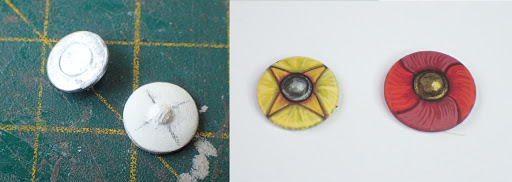I had painted the Asgard (Table Top Games, by the time I got them and Alternative Armies today) Late Roman Army Command group of a general and standard bearer some time in the early 1980s but then they languished in a box with the rest of this incomplete army. On digging them out again, on close inspection, the general figure was far below the standard I try to achieve today so it went into the paint stripper jar but I really wanted to use the standard (the Labarum of Constantine I from page 82 of WRG Armies and Enemies if Imperial Rome0 that I had so painstakingly painted all those years ago, even if such a massive standard seems an unlikely candidate to be carried by a cavalryman and now belongs in the same WRG rejects pile as all my leather cuirassed Legionaries. For the standard bearer, I limited myself to a bit fo tidying up and repainting his cloak. With a repainted general and Minifigs heavy cavalryman as bodyguard, I'm quite pleased with this little group. The cavalryman's shield is the WRG interpretation of the Notitia Dignitatum for the Scola Scutariorum Secunda. I might use this design for all the general's bodyguards; as though this unit of guard cavalry had been split up to protect all of the senior leaders.
I've always struggled a bit with painting grey horses - and horses in general to be honest - but I was quite pleased with this one in the end, acknowledging the limitations of scale and that I was aiming for a nice effect and popping colours rather than real equine accuracy. I think I might do a few more for other officers.
I'm building this army for Mortem et Gloriam rules which categorises generals as Legendary, Talented, Competent or Mediocre and suggests identifying them with red, yellow, green or white (respectively) base edges or declining numbers of figures from 5 to 2 per 40 x 40 mm base. Neither of these options seem satisfactory to me, either aesthetically or for practical flexibility - what if I want to play around with army composition and need a different mix of generals?
I wanted something that would be obvious, unambiguous but subtle and flexible. I considered different coloured standards or dracos but, apart from not having enough spare dracos, I'd painted my army standard almost 40 years ago and wasn't about to recolour it and make a spare. In the end, I decided to try adding an interchangeable shield in the appropriate colour, held in place by a magnet.
After digging around in the garage, I found a couple of steel washers, of 9 and 10 mm diameter and turned them into shields with the aid of some Miliput. I wanted to create some visual interest and make them look like the sort of thing that might be carried by barbarian enemies or Rome whilst sticking to the colour theme - for these test cases red and yellow. The overall effect worked well but the 3 mm rare earth magnet that I used is far too strong. For the other generals, I'll use offcuts of magnetic basing tape so I can swap the shields round without damaging them.





Lovely retro Late Roman command! Standard is ace,if a little large but then they tended to be in the 80s as everything had to be hand painted, love the gray and the general is super too!
ReplyDeleteBest Iain
Thanks Iain, this whole army is going to be a bit of a mix of retro and modern. The standard certainly is huge - not quite sure how they thought it could be balanced on horseback, it looks more like the type of thing to mount on a cart to me!
DeleteSuperb command group, the standard is outstanding and an ingenious solution for categorising your generals.
ReplyDeleteThanks for the kind comments Cyrus. Although it was 35+ years ago, I remember taking a really long time to paint the face on the standard so, despite my misgivings about the historical accuracy of such a huge standard held by a cavalryman, I had to make use of it.
Delete